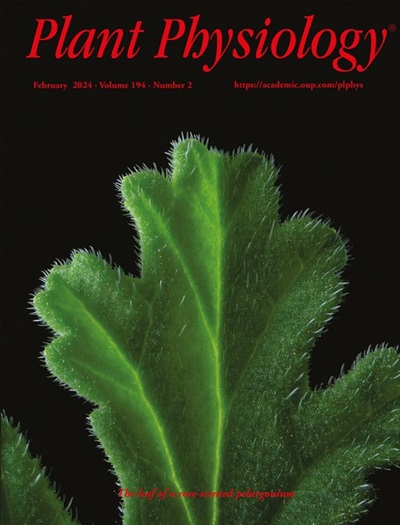质膜和细胞质分区:花粉管尖端生长所需的动态结构框架
IF 6.5
1区 生物学
Q1 PLANT SCIENCES
引用次数: 0
摘要
快速、单向的花粉管顶端生长对受精至关重要,并被广泛用作极性细胞扩增的模型,而极性细胞扩增是植物形态发生的关键过程。在控制极性细胞扩展过程中起关键作用的不同蛋白质和脂质与花粉管顶端质膜(PM)的不同结构域有关。在花粉管顶端生长过程中,这些膜域需要动态维持,而这取决于大量的分泌膜和内细胞膜贩运。目前,人们对花粉管质膜分区的分子和细胞机制知之甚少。为了给这些机制的进一步表征提供一个可靠的结构框架,我们对正常生长的烟草(Nicotiana tabacum)花粉管中 1)富含关键信号蛋白或脂质;2)显示高膜序;或 3)与在顶端膜贩运中起重要作用的细胞质结构相接触的 PM 结构域的相对位置绘制了一张综合定量图。之前确定的分泌型和内吞型 PM 结构域也被纳入了这一图谱。与横向内吞结构域重叠的 PM 区域相关的调节蛋白或脂质的内化情况是根据布雷非德菌素 A(BFA)处理进行评估的。这些分析揭示了烟草花粉管顶端结构组织的重要方面,1)加深了我们对顶端生长的细胞和调控过程的理解,2)突出了未来研究的重要领域。本文章由计算机程序翻译,如有差异,请以英文原文为准。
Plasma membrane and cytoplasmic compartmentalization: a dynamic structural framework required for pollen tube tip growth
Rapid, unidirectional pollen tube tip growth is essential for fertilization and is widely employed as a model of polar cell expansion, a process crucial for plant morphogenesis. Different proteins and lipids with key functions in the control of polar cell expansion are associated with distinct domains of the plasma membrane (PM) at the pollen tube tip. These domains need to be dynamically maintained during tip growth, which depends on massive secretory and endocytic membrane trafficking. Very little is currently known about the molecular and cellular mechanisms responsible for the compartmentalization of the pollen tube PM. To provide a reliable structural framework for the further characterization of these mechanisms, an integrated quantitative map was compiled of the relative positions in normally growing Nicotiana tabacum (tobacco) pollen tubes of PM domains 1) enriched in key signaling proteins or lipids, 2) displaying high membrane order, or 3) in contact with cytoplasmic structures playing important roles in apical membrane trafficking. Previously identified secretory and endocytic PM domains were also included into this map. Internalization of regulatory proteins or lipids associated with PM regions overlapping with the lateral endocytic domain was assessed based on brefeldin A (BFA) treatment. These analyses revealed remarkable aspects of the structural organization of tobacco pollen tube tips, which 1) enhance our understanding of cellular and regulatory processes underlying tip growth, and 2) highlight important areas of future research.
求助全文
通过发布文献求助,成功后即可免费获取论文全文。
去求助
来源期刊

Plant Physiology
生物-植物科学
CiteScore
12.20
自引率
5.40%
发文量
535
审稿时长
2.3 months
期刊介绍:
Plant Physiology® is a distinguished and highly respected journal with a rich history dating back to its establishment in 1926. It stands as a leading international publication in the field of plant biology, covering a comprehensive range of topics from the molecular and structural aspects of plant life to systems biology and ecophysiology. Recognized as the most highly cited journal in plant sciences, Plant Physiology® is a testament to its commitment to excellence and the dissemination of groundbreaking research.
As the official publication of the American Society of Plant Biologists, Plant Physiology® upholds rigorous peer-review standards, ensuring that the scientific community receives the highest quality research. The journal releases 12 issues annually, providing a steady stream of new findings and insights to its readership.
 求助内容:
求助内容: 应助结果提醒方式:
应助结果提醒方式:


